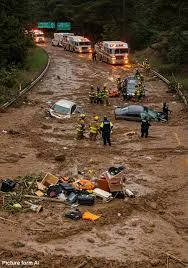A massive mudslide caused by heavy rainfall blocked a rural interstate highway in southern West Virginia, stranding thousands of motorists for over eight hours on a chilly Friday morning. The mudslide, which occurred on a particularly treacherous stretch of the highway, was the result of a storm drain becoming overwhelmed by intense rainfall from the previous night.
According to eyewitnesses, the storm drain’s blockage led to severe flooding in the northbound lanes, with mud and debris covering the road. As the situation unfolded, a long line of vehicles became trapped, with some drivers reporting being stuck for more than eight hours.
“I was on my way to work when suddenly, the road was just gone,” said one motorist, who wished to remain anonymous. “There was mud everywhere, and cars were trying to navigate through it. It was chaos.”
Emergency services and road crews worked tirelessly to clear the highway and assist stranded drivers. “Our teams are doing their best to get the road open as soon as possible,” said a spokesperson for the West Virginia Department of Transportation. “We understand the inconvenience this has caused and appreciate the public’s patience.”
The incident highlights the challenges of maintaining infrastructure in rural areas prone to extreme weather conditions. As climate change continues to impact the region, residents and authorities are bracing for more intense storms and potential disruptions.
The cause of the mudslide is currently under investigation, with officials pointing to the intense rainfall as a primary factor. “We’re seeing more frequent and severe weather events, and it’s putting a strain on our infrastructure,” said a local official.
As the cleanup efforts continue, drivers are advised to check for updates before embarking on their journeys and to exercise caution when navigating rural roads. The incident serves as a reminder of the importance of maintaining and upgrading infrastructure to withstand the impacts of climate change.

In Depth report; Mudslide on West Virginia Highway*
*Executive Summary*
A significant mudslide occurred on a rural interstate highway in southern West Virginia, causing widespread disruptions and stranding thousands of motorists for over eight hours. The incident, triggered by heavy rainfall, highlights the vulnerability of infrastructure to extreme weather events and underscores the need for proactive maintenance and upgrades.
*Incident Overview*
On Friday morning, a mudslide blocked a section of northbound lanes on a mountainous stretch of interstate highway in southern West Virginia. The mudslide, resulting from a storm drain blockage caused by intense rainfall the previous night, led to severe flooding and debris accumulation on the road.
*Causes and Contributing Factors*
1. *Heavy Rainfall*: Prolonged and intense rainfall on the previous night overwhelmed the storm drain, leading to the blockage and subsequent mudslide.
2. *Infrastructure Vulnerability*: The rural location and mountainous terrain of the highway made it prone to landslides and erosion.
3. *Storm Drain Capacity*: The storm drain’s design capacity may have been insufficient to handle the volume of rainfall, contributing to the blockage.
*Response and Mitigation Efforts*
1. *Emergency Services*: Local emergency responders and road crews worked to clear the highway and assist stranded drivers.
2. *Road Clearance*: Crews employed heavy machinery to remove debris and mud, restoring traffic flow.
3. *Traffic Management*: Authorities implemented traffic controls to manage the flow of vehicles and minimize further disruptions.
*Impact and Consequences*
1. *Traffic Disruptions*: Thousands of motorists were stranded for over eight hours, causing significant delays and disruptions to daily commutes.
2. *Economic Impact*: The incident may have resulted in lost productivity, missed appointments, and economic losses for local businesses.
3. *Safety Concerns*: The mudslide posed a significant risk to driver safety, highlighting the importance of prompt response and effective traffic management.
*Recommendations and Future Actions*
1. *Infrastructure Upgrades*: Regular inspections and maintenance of storm drains and highways are crucial to preventing similar incidents.
2. *Emergency Preparedness*: Enhancing emergency response plans and conducting regular drills can improve response times and effectiveness.
3. *Climate Resilience*: Incorporating climate resilience into infrastructure design and planning can help mitigate the impacts of extreme weather events.
*Conclusion*
The mudslide on the West Virginia highway serves as a reminder of the importance of proactive infrastructure maintenance, emergency preparedness, and climate resilience. By understanding the causes and consequences of this incident, authorities can take steps to mitigate the risk of similar events and ensure the safety and reliability of the transportation network.
